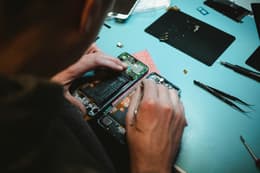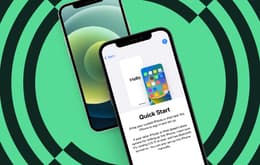
Why you should care about the right to repair movement.
Picture this. You’ve just dropped your phone down the toilet. It’s wet, cracked and the screen is no longer legible. What do you do?
Nine times out of 10, people's first instinct is to buy new. But why? Whether you live near a Genius bar or not, repairing your device is not always as straightforward as it should be. Not only are prices often astronomical, but manufacturers are making it tricky for consumers to repair their devices quickly and efficiently.
“Repair shops and repair jobs have almost disappeared from our economies in the last 20 years,” said iFixit CEO Kyle Wiens at our Climate Week event in New York. “Companies – from Nikon and Canon in the early days to Apple today – made repair inconvenient, so people stopped. Only $3 of labor goes into making a new phone, but $30 of labor goes into refurbishing one. We can bring these jobs back by making repair accessible.”
The digital sector accounts for up to 4% of global greenhouse gas emissions – that’s 1.5 times more than the aviation sector. And with our overconsumption of new devices that are not repaired or reused, it’s not going to stop there.
With people replacing their devices on average every 2 to 3 years, electronic waste (e-waste) has become the fastest-growing waste stream in the world.

According to a recent report published by the ITU and UNITAR, 62 million metric tons of e-waste was generated in 2022. That’s enough to fill 1.55 million 40-ton trucks – roughly enough to form a bumper-to-bumper line encircling the equator.
And that’s only what’s been recorded. Research from the UN suggests, less than a quarter of 2022’s e-waste mass was documented, leaving $62 (US) billion worth of recoverable natural resources completely unaccounted for. If things don’t improve, we’re on track to reach 82 million metric tons of e-waste per year by 2030.
So what’s the solution?
That lies in something called the ‘right to repair’. The Right to Repair movement has gained momentum within the tech industry in the last few years, with its mission to help extend the life of our devices by making repair a fundamental right, and refurbishment easier.
This coalition of European organizations – that includes Back Market as a proactive member in the steering committee – has over 130 members in 23 countries and includes NGOs, businesses, and repairers.
What is right to repair, and why is it important?
Why do we need a right to repair movement?
The answer is simple. Being able to repair a device is key to tackling climate change. If we can extend the lifespan of our devices, it lowers carbon emissions and the extraction of raw materials like gold, aluminum, and copper.
Despite this, device manufacturers are pushing consumers to buy new and it shows in the design. In extreme cases, devices are made impossible to open. And in more frequent cases, major components are soldered or glued together, repairing even harder.
But design isn’t the only way that manufacturers prevent repair. Monopolistic business practices mean they rarely provide official spare parts and repair information to independent repairers or refurbishers, or if they do, it's at a disproportionate price.
At Back Market we have fought passionately against part pairing. Part pairing is probably something you’ve never heard of, but it matters to everyone with a device. In short, it’s a mechanism put in place by manufacturers designed to limit and block third-party repairs. Here’s an example – say an independent refurbisher changes a spare part with one not provided by the original manufacturer – a warning notification will appear, giving consumers the impression that something is wrong, even when that isn’t the case.
“Back Market is passionate about fighting against part pairing because it blocks consumers and our sellers from performing repairs, limiting the life of electronic devices," says Back Market tech expert, Kewin Charron. "By allowing easier access to parts, we can extend the life of devices, reduce electronic waste, and give consumers more control over their tech.”
What is planned obsolescence?
Planned obsolescence is a business strategy within tech where devices are intentionally made to have a limited lifespan and become outdated. This encourages consumers to replace them frequently. This can be done through constructing items with low-quality or hard-to-repair materials, providing a lack of necessary updates, or building intentionally restrictive features that encourage further purchase.

Change is on the horizon
2023 and 2024 have seen some significant wins in Europe for the right to repair movement. In April this year, a new law came into force that supports independent repair and improves consumer affordability if you’re looking to buy smartphones, tablets, and batteries. The new European law also mandates manufacturers to provide spare parts at a reasonable price to prevent them from using any unfair anti-repair practices.
René Repasi, politician and member of the European Parliament said it perfectly: “This is a significant achievement for Parliament in the fight against climate change. The new legislation extends legal guarantees by 12 months when opting for repair, gives better access to spare parts [plus] easier, cheaper and faster repair.”
But the fight is far from over.
What’s next?
The movement is now campaigning to secure repairability rules for many more devices including laptops, game consoles and other home appliances. There’s also a push for manufacturers to extend the length of time software updates are available. For example, if you have the iPhone 6 you can no longer update your software – that means your phone is more or less obsolete. However extending the availability of software will extend the lifespan of our devices, so cases like this don’t continue to be the norm.
Of course, it takes years for these legislations to come into effect (we estimate between 2025 and 2027). So that’s why we must keep pushing.
What about in other countries?
In the United States, there has been a global effort to pass "Fair Repair" legislation. So far, bills have been passed in states including New York, Colorado, California, Oregon, and Minnesota.
In the meantime, repair advocates are working to introduce laws in various countries and regions.

How do I get involved?
October 19 is International Repair Day and the right to repair movement is looking for collective action.
Here are some of the things you can do to get involved:
1. Share this article to get people talking
2. Make a complaint! Have you struggled to get repair materials from a manufacturer? Repair.org is collecting evidence of manufacturers who aren’t giving customers access to parts, tools and documentation. Share your experiences with repair.org.
3. Participate in an upcoming event to protect consumer rights. You can find more information HERE.
The more we spread the word, the better chance of bills being passed. So get talking.















